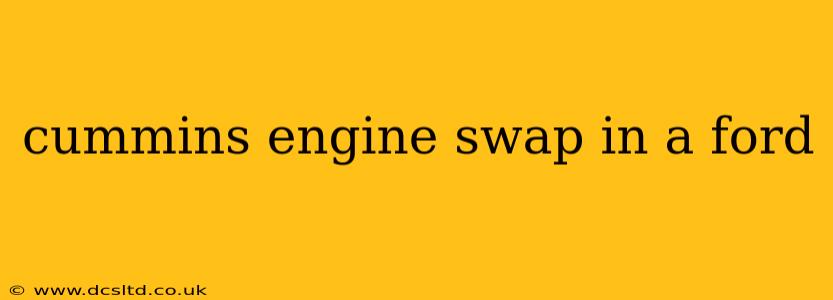Swapping a Cummins engine into a Ford vehicle is a popular modification among enthusiasts seeking increased power and torque. This comprehensive guide explores the complexities, considerations, and steps involved in this ambitious project. While seemingly straightforward, a Cummins swap is a significant undertaking requiring mechanical expertise, specialized tools, and substantial financial commitment.
Why Swap a Cummins into a Ford?
The allure of a Cummins engine swap stems from the renowned reliability, power, and torque output of Cummins diesel engines. These engines are known for their longevity and ability to handle heavy loads, making them a desirable upgrade for Ford trucks and other vehicles. The increase in towing capacity and overall performance is a key motivator for many enthusiasts.
What Ford Vehicles are Commonly Used for Cummins Swaps?
Several Ford models are popular choices for Cummins engine swaps. These include, but are not limited to:
- Ford F-Series Trucks: The F-250, F-350, and F-450 are frequently targeted due to their robust chassis and existing capacity for heavy-duty engines.
- Ford Broncos: While less common, some enthusiasts have successfully completed Cummins swaps in older Ford Broncos, transforming them into powerful off-road vehicles.
The specific model significantly influences the complexity of the swap. Older models generally offer more flexibility due to less stringent emission regulations and simpler electrical systems.
Which Cummins Engine is Best for a Ford Swap?
The ideal Cummins engine for a Ford swap depends heavily on the recipient vehicle and desired performance goals. Popular choices include:
- 4BT: This inline-four is a smaller, lighter option, often preferred for older, lighter vehicles. It's relatively simpler to install but sacrifices some of the raw power of larger engines.
- 6BT: The inline-six 6BT is a workhorse and a very common choice for swaps. It offers a significant increase in power and torque compared to the 4BT.
- ISB: Larger and more powerful than the 6BT, the ISB is usually reserved for heavier-duty Ford trucks and requires more extensive modifications.
Choosing the right engine size is crucial for balancing performance with the vehicle's structural integrity and handling capabilities.
What are the Challenges of a Cummins Engine Swap in a Ford?
A Cummins engine swap is not a weekend project. Significant challenges include:
- Engine Mounts and Frame Modifications: Adapting the Cummins engine to the Ford chassis requires custom engine mounts and potentially frame modifications to accommodate the engine's larger size and weight.
- Transmission Compatibility: The Cummins engine may not directly mate with the existing Ford transmission. Finding a compatible transmission, or adapting the existing one, is crucial.
- Electrical System Integration: Integrating the Cummins engine's electrical system with the Ford's existing wiring harness can be complex and requires specialized knowledge.
- Exhaust System Fabrication: A custom exhaust system will be necessary to route the exhaust gases from the Cummins engine, ensuring compliance with emissions regulations where applicable.
- Cooling System Modifications: The Cummins engine's cooling requirements might exceed the Ford's existing cooling system capacity, necessitating upgrades or modifications.
What is the cost of a Cummins engine swap?
The cost of a Cummins engine swap varies greatly depending on the specific engine used, the vehicle's model, the level of customization, and the labor involved. You could expect to spend anywhere from $10,000 to $30,000 or more. This includes the cost of the engine, transmission, custom parts, and professional labor if you opt to have the work done.
How long does a Cummins engine swap take?
The timeframe for a Cummins engine swap is significantly influenced by the experience level of the mechanic and the complexity of the project. It can range from several weeks to several months. The integration of the electrical systems and fabrication of custom components often contribute to the overall duration.
Is a Cummins swap legal?
The legality of a Cummins engine swap depends heavily on local and state regulations. Modifications that affect emissions and safety standards might need to be inspected and approved. It’s vital to research and comply with all relevant regulations in your area before, during, and after the swap to ensure legal operation of the modified vehicle.
What are the benefits of a Cummins swap?
Besides the considerable increase in power and torque, a successful Cummins swap can yield several benefits:
- Increased Towing Capacity: Cummins engines are renowned for their towing capabilities, significantly improving the vehicle’s towing capacity.
- Improved Reliability: Cummins engines are known for their durability and reliability, potentially exceeding the lifespan of the original Ford engine.
- Enhanced Fuel Efficiency (potentially): While not guaranteed, depending on the original engine, a Cummins can deliver better fuel efficiency.
- Increased Resale Value (potentially): A well-executed Cummins swap can enhance the vehicle's value, provided it's done correctly and legally.
Successfully swapping a Cummins engine into a Ford is a challenging but rewarding endeavor. Thorough planning, specialized knowledge, and access to the right tools and resources are crucial for a successful outcome. This comprehensive guide should serve as a helpful starting point, but remember to consult with experienced mechanics and enthusiasts throughout the process.
